The Apple iPad Review (2012)
by Vivek Gowri & Anand Lal Shimpi on March 28, 2012 3:14 PM ESTThe Display: In Numbers
Apple is very big on maintaining a consistent experience between its products. We see this a lot in our Mac reviews where it's not unusual to see similar white points across virtually all Apple products. It's no surprise that the with the move to the Retina Display Apple wanted to retain as much of the original iPad's display characteristics as possible. We'll start with an analysis of brightness and contrast, both of which remain relatively unchanged from the iPad 2:
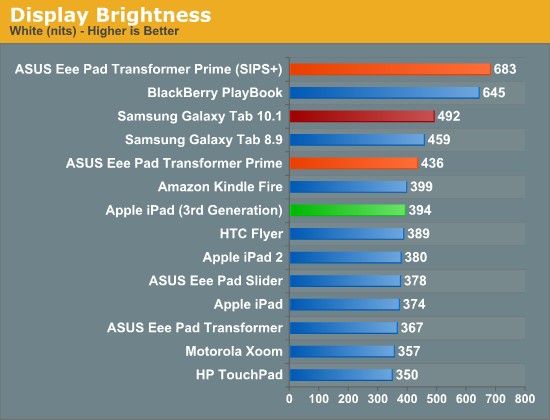
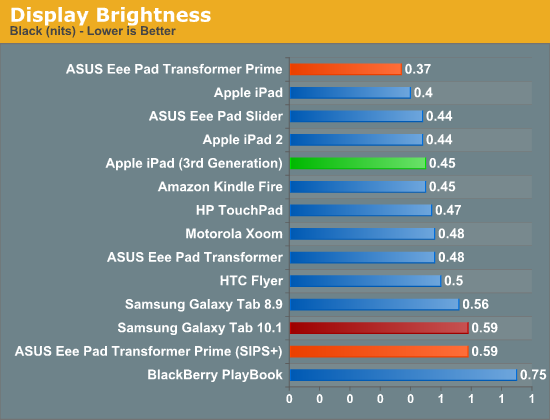
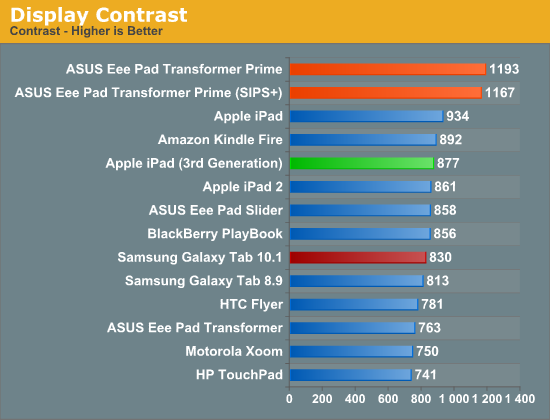
Apple is expected to have triple sourced panels for the new iPad, so you can expect to see variation in these results but for the most part you can expect the new iPad's display to perform similarly to the previous model.
Despite similar brightness and contrast to the previous model, the new iPad offers remarkably better color gamut and color reproduction than its predecessor. Relative to other tablets, the iPad's display is spectacular.
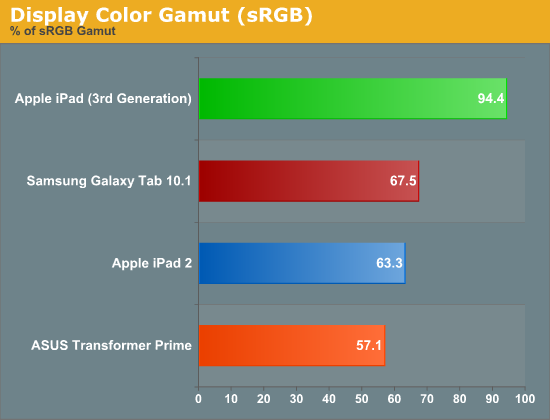
As we mentioned in our Retina Display analysis, Apple delivered on its claims of a 44% increase in color gamut. The new iPad offers nearly full coverage of the sRGB color space and over 60% of the Adobe RGB gamut:
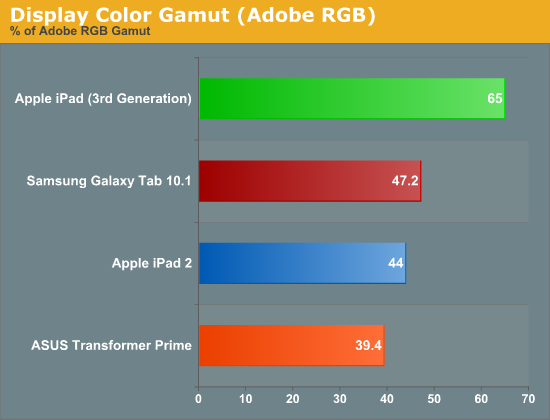
Below is the CIE diagram for the new panel with an sRGB reference plotted on the same chart so you can visualize the data another way:
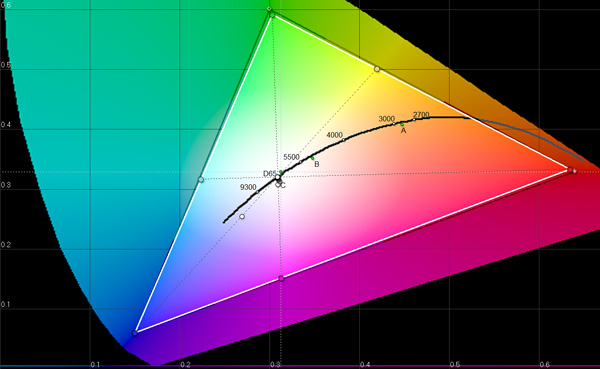
Color accuracy has improved tremendously if we look at delta E values for the primary and secondary colors:
Remember from our display reviews, lower delta E values indicate greater color accuracy. Values below 4 are typically considered good and you can see that the iPad 2 as well as the Transformer Prime both fell short in this department. With the new iPad Apple has clearly focused on color accuracy, which makes sense given it was used as the vehicle to introduce iPhoto for iOS.
Apple still has a lot of work ahead of itself to really put forth a professional quality display in a tablet, but for now the Retina Display is easily the best we've seen in a tablet and a tremendous step forward.
What's most absurd about the iPad's Retina Display is that you're able to get this resolution and panel quality in a $499 device. While we must be careful not to give Apple too much credit here as Samsung, Sharp and its other display partners clearly make the Retina Display, it's obvious that Apple has really been pushing its partners to develop solutions like this.
The biggest problem in the production of any commoditized component is the primary motivation for innovation is to lower cost. For years I argued with notebook PC makers to use higher quality LCD panels but no one was willing to commit to the quantities that would lower costs enough. I was also told that as soon as you put these notebooks on shelves at Best Buy, users wouldn't really care whether they were getting a high quality IPS display or not—all that mattered was the final price.
Apple, under the leadership of Steve Jobs, had a different mentality. Steve's pursuit was quality and experience, cost was a secondary concern. Through slow and steady iteration of this approach, Apple was able to build up a large enough customer base and revenue to be a significant force in the industry when it came to driving costs down. Apple can easily fill your fabs and eat all that you can produce, but you'll have to do whatever it wants to get the order.
Apple's behavior since it got rich has been to drive down the cost of higher quality components, LCDs being a perfect example. Unfortunately other companies don't benefit as much here as Apple tends to buy up all of the production of what it has pushed to create. That's one reason why, although ASUS was first to introduce a 1080p Transformer Pad, it won't launch until well after the new iPad. From what I've heard, the panel makers are all busy servicing Apple's needs—everyone else comes second.
Eventually the entire industry will benefit and all indications point to Apple doing something special for "pro" users in the notebook space next. As I've said previously, Apple has raised the bar with the iPad's Retina Display. The time for average display quality in a $500 tablet is over, the bar has been raised. It remains to be seen whether or not Apple will be able to maintain this quality across all suppliers of its Retina Display. On the iPhone Apple has been entirely too lax about maintaining consistency between suppliers. If it wants to be taken seriously in this space Apple needs to ensure a consistent experience across all of its component vendors.

















234 Comments
View All Comments
seanleeforever - Thursday, March 29, 2012 - link
Correction: YOU won't buy it doesn't mean the rest of us won't buy it.PS3/XBOX came out in 2005, or about 7 years now. i have no issues buying the latest game and still play.
what phone or pad did you have 7 years ago? oh, you have nothing... heck, the phones/pads you bought 3 years ago probably wont' be able to run today's game.
tipoo - Wednesday, March 28, 2012 - link
Tegra Zone enhancements, the article mentions that.PeteH - Wednesday, March 28, 2012 - link
What mechanism is being used to upscale legacy (1024x768) apps? Pixel doubling? Bi-cubic? Bi-linear? Something else?Guspaz - Wednesday, March 28, 2012 - link
At the most basic level, pixel doubling. However, text that is rendered through iOS gets a free resolution boost so long as the app was compiled with the latest version of xcode. It's pretty common on the iPad 3 to see apps where the interface elements are low-res, but all the text is high-res. And in apps that are predominantly text (like an SSH client, for example), that's all that really matters. Who cares if the triangle picture on a button isn't high res?For stuff like games, that stuff is just pixel doubled.
PeteH - Wednesday, March 28, 2012 - link
I'm not saying you're wrong, but how do you know games (for example) utilize pixel doubling?Guspaz - Wednesday, March 28, 2012 - link
I know because I can look at a game that doesn't support the new screen (such as Plants vs Zombies HD) on my iPad 3 and see that it's using pixel doubling? It does the same for iPhone apps when you use the 2x zoom option. One thing I have not tried is an old 320x480 iPhone app. I'm curious, since that would require 4x zoom.Newer games may choose to render at a lower resolution and then upscale using some sort of filter (perhaps even on the GPU), but at that point they are specifically targeting the new display. An older game that is completely oblivious to the newer display is scaled by the OS using pixel doubling without any interaction from the game.
Steelbom - Thursday, March 29, 2012 - link
Actually, when using iPhone apps, the iPad uses the 640x960 version rather than the 320x480 version, if available.mosu - Wednesday, March 28, 2012 - link
A person in his 50's doesn't care about 300dpi res because he only sees 200dpi, so retina display is just for kids? I really don't get why Apple did not use a standard res panel like 1920x 1200 if they wanted a greater quality image.It means they're stuck with a single form factor?PeteH - Wednesday, March 28, 2012 - link
It's much easier to stick with a single aspect ratio, especially for the developers. Your app looks the same on every device (albeit sharper on higher DPI displays), no need to tweak things for multiple aspect ratios.Sabresiberian - Thursday, March 29, 2012 - link
Umm, where do you get this idea?Generalized statements about vision limitations in humans are usually taken out of context, at best.
;)